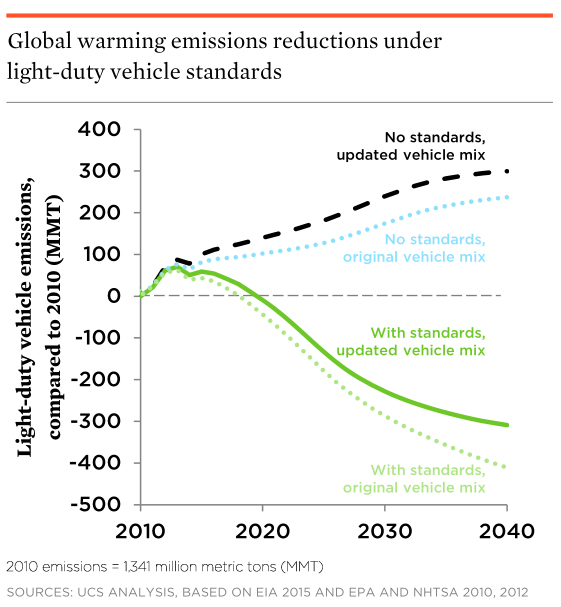In 2012, the Environmental Protection Agency (EPA) and National Highway Traffic Safety Administration (NHTSA) set joint fuel economy and global warming emissions standards for passenger vehicles out to 2025. These standards (taken together with those finalized in 2010), which cover new vehicles sold from 2012 through 2025, represent the biggest step the country has taken to reduce oil use and global warming emissions, and it’s already paying dividends.
Due to a limitation of NHTSA’s authority that says the agency can finalize standards for no more than five years at a time, this policy is currently undergoing a “mid-term review.” This review process will examine the regulations in light of many factors that may have changed over the past four years, including unforeseen technology advancements, changes in consumer acceptance, and lower fuel prices. The process is currently underway but will be formally kicking off with a draft technical assessment report to be released shortly, upon which the agencies will ask for public comment.
To help everyone make sense of these rules, UCS is beginning a fact sheet series on the mid-term review to discuss various issues of concern. The first three fact sheets are being released today, and we will continue to release new fact sheets over the coming months to help illustrate why these standards are important, what they mean for consumers, and why automaker efforts are better spent on continued innovation instead of lobbying for less stringent regulation. Nothing that has happened in the past four years suggests that these standards should be weakened—in fact, given the technology development spurred to-date, this is an opportunity to strengthen the standards for 2025.

Without strong fuel-economy standards in place, global-warming emissions from passenger vehicles would skyrocket to levels even higher than anticipated in 2012. Flexible standards help reduce emissions; however, consumers buying more trucks and SUVs means that a stronger rule will be necessary to achieve the agencies’ original projected level of improvement.
SUVs don’t make the standards harder to achieve—they make them more important
Whether it’s because of low gas prices or more efficient SUV choices, it’s clear that consumers have been buying more SUVs than ever before. But despite automaker pleas, that isn’t a reason to weaken the standards.
These standards were designed to give consumers efficient vehicle choices across all sizes and types of vehicles, and that’s exactly what they’ve done. Automakers are selling more efficient cars, trucks, and SUVs alike, which is why they find themselves well ahead of the regulatory targets.
Without these standards, increasing sales of SUVs would have moved fuel economy backwards, just as it did more than a decade ago. However, we will need even stronger standards in order to move forward on our climate and oil use targets in 2030 and beyond.
Automakers are innovating beyond what the regulators thought possible
By setting targets for 2025, regulators gave suppliers and automakers a clear long-term goal, helping to spur significant investment in technology development and deployment—and that investment is paying off. Automakers have come up with low-cost ways to get more out of vehicles powered by internal combustion engines that the regulators never saw coming.
The forthcoming draft technical assessment report will give new insight into what the technology landscape looks like, but our analysis shows that there are a number of developments that the federal agencies didn’t foresee back in 2012:
- High-compression engines prove that you don’t need a turbocharger to get more out of a smaller engine—with up to a 15 percent improvement over the conventional engine, Mazda’s SKYACTIV engine is an example of how successful this technology can be and a major reason for Mazda’s position as the most efficient vehicle manufacturer.
- With nine– and ten-speed transmissions coming on the market and the wide deployment of efficient continuously variable transmissions, automakers are continuing to find new ways to make sure the internal combustion engine is running at its most efficient point, regardless of vehicle speed.
- Cylinder deactivation has been around for years on larger engines, but novel control strategies from suppliers and automakers alike will see improvements of up to 10 percent applicable in even small engines.
- Lighter vehicles require less energy, and investments in materials and manufacturing will continue to see wider deployment of lightweighting across the fleet, whether that’s advanced carbon fiber, high-strength steel, new aluminum alloys, magnesium alloys, or even lightweight polymers. Vehicles like the Chevy Malibu and Ford F-150 are shedding hundreds of pounds to save fuel, a trend is continuing across all manufacturers.
- One of the most obvious ways that a hybrid saves fuel is by shutting off the engine while parked at a stoplight. New 48V stop-start systems developed for conventional vehicles can also save fuel in this way, while also enabling additional functionality and flexibility, such as power for more responsive electric turbochargers or additional e-boost capability.
These technologies are just a small sampling of the technology innovation occurring across the automotive industry, innovation which was unanticipated and helps build the case for why automakers can go do even more than originally expected in 2025.
The fact sheet series is available at www.ucsusa.org/midtermreview. Stay tuned for future installments.
